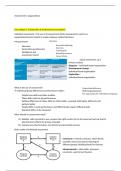College aantekeningen
Assessment in organizations - samenvatting
- Instelling
- Tilburg University (UVT)
Volledig overzicht met alles wat je nodig hebt om het vak 'Assessment in organizations' te halen. Met plaatjes, overzichten, stappenplannen en tabellen. Duidelijk de theorie puntsgewijs samengevat. 7,5 voor het schriftelijke tentamen gehaald. Vak in het Engels gegeven dus aantekeningen en begrippen...
[Meer zien]




